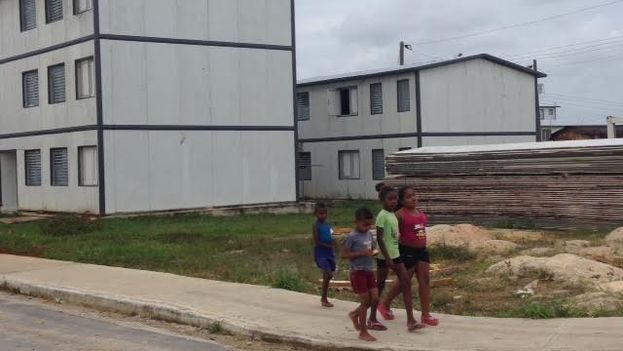
![]() 14ymedio, 28 January 2016 — On Tuesday, the residents of El Molino neighborhood in Havana’s Cotorro district, were summoned in two groups to the municipal People’s Power to be informed that within a period of no more than 18 months they will be relocated into other housing, due to the calamitous state of the “petrocasas” (oil-houses) they were given less than a year ago.
14ymedio, 28 January 2016 — On Tuesday, the residents of El Molino neighborhood in Havana’s Cotorro district, were summoned in two groups to the municipal People’s Power to be informed that within a period of no more than 18 months they will be relocated into other housing, due to the calamitous state of the “petrocasas” (oil-houses) they were given less than a year ago.
A report titled “The Oil-houses are Falling Apart,” published by 14ymedio last week, revealed the deterioration and lack of finishes seen in the buildings and the infrastructure of this Havana settlement. The residents’ discontent had led to a situation that is “ready to explode,” confessed a resident of the area.
According to the testimonies of several local residents who participated in the meeting on Tuesday, the president of the Municipal Assembly, Teresa Beltran Santana, let them know that their complaints had reached those “very high up” and that according to studies, “the buildings had barely a year of life left in them.”
Zoraida Dopico, the mother of two children who lives in El Molino, is surprised by the solution they’ve been promised and adds, “Everyone knows that this was all constructed in a big rush and that it wouldn’t survive the first hurricane. When we complained that we were in danger, many said we were exaggerating,” says the woman.
Dopico confirms the long list of complaints and letters sent to official institutions. “We went to see Esteban Lazo, President of Parliament, and wrote letters to all levels … The problem even came out on the Internet!” said the lady, referring to the report published in this newspaper.
Carlos, whose testimony was collected in 14ymedio’s first report, recalls that shortly after the buildings were inaugurated, staff from the government TV program “Cuba Dice” (Cuba Says) came by. However, “they only told them about buildings with Chinese technology, which are concrete,” the elderly man remembers. The petrocasas are made from polyvinyl chloride panels.
With a certain sarcasm, the man predicted “surely at some moment they will show up here and they always find someone who seems content to have a microphone shoved in their face.”
Some were more cautious from the start and didn’t let their dreams run away with them in the petrocasas settlement, as is the case with a retired construction worker who commented, “It was clear to me, they didn’t even change the addresses on our ID Cards. Now with the move I’m not going to have to go to the end of the line because according to the paperwork I was never here,” he smiled.
For some, like Zoraida Dopico, the problem does not end with the transfer of the residents to another location. “The worst thing is that nobody cares who’s going to pay for all this. These components were brought from Spain, they paid salaries and spent millions doing it all so badly,” said the neighbor.
When asked if the government will find homes for so many people in less than a year and a half, she replied: “They do not want to see people here explode and if this problem isn’t solved quickly, what is going to develop here is going to be a revolution.”
Cuba faces a profound housing crisis with a deficit of more than 600,000 homes, and also a lack of maintenance of the buildings that are in a precarious state. According to official data, of 3.7 million properties in the country, almost 40 percent are in poor condition. However, only 27,000 homes were built in 2015.
